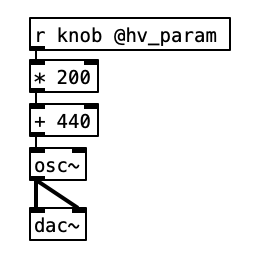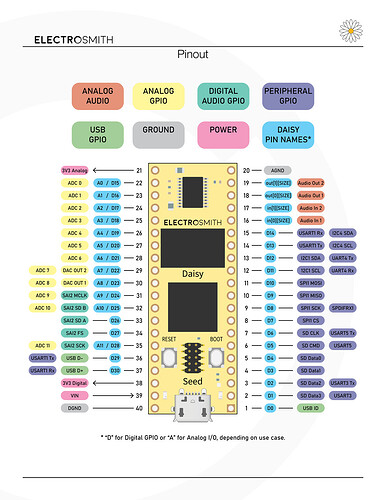Hey mrlargefoot!
You came to the correct place! I wrote a quick tutorial over on our discord server, so I’ll migrate it over here for you. We’re planning on making a video about in the near future (I actually have the script done), but this guide should get you started.
–
Here, we have a [receive] object that has “knob” as an argument. The idea is that we want that object to output 0.0 to 1.0 when we twist a potentiometer that’s connected to the Daisy in the physical world.

But, flashing this patch without any custom JSON won’t do anything. So, let’s have a custom JSON that will get this working!
Here’s customseed.json
{
"name": "customseed",
"som": "seed",
"components": {
"knob": {
"component": "AnalogControl",
"pin": 15
}
}
}
You can copy and paste this into a .txt file (plain text and not rich text) using TextEdit for example. And you can simply change the extension from .txt to .json.
You may have noticed that there’s “knob” in this JSON file. As you guessed it, that corresponds to "knob" in the [receive] object!
But how does it know which pin the potentiometer’s analog out is connected to? That’s where that "pin": 15 comes in.
pin 15 corresponds to ADC 0 on the Daisy (please see the attach diagram. A0 = D15). I’m assuming you have a bit of Arduino experience (if not, no worries! I’m going over the electronics basics in the video), so that’s where the potentiometer’s analog out pin should be connected to.
So! After connecting the potentiometer to ADC 0, 3.3 volt, and ground (also don’t forget to bridge the DGND and AGND together for the analog value to be read effectively) and getting the .pd and .json selected in pd2dsyGUI (or plugdata), you can simply flash to the Daisy. I’m just gonna assume that you have the audio jack connected to the Daisy (I show this towards the end of the recent pd2dsy setup video, but I’ll go over this in more detail in the analog IO video).
After the program is flashed, you can twist the knob and the pitch of the oscillator should change!
What about adding more sensors?
Here’s an example of what that would look like!
{
"name": "customseed",
"som": "seed",
"components": {
"knob": {
"component": "AnalogControl",
"pin": 15
},
"ribbon1": {
"component": "AnalogControl",
"pin": 16
},
"ribbon2": {
"component": "AnalogControl",
"pin": 17
},
"fsr1": {
"component": "AnalogControl",
"pin": 18
},
"fsr2": {
"component": "AnalogControl",
"pin": 19
}
}
}
–
Let me know if you have any questions!
I can also talk about digital ins (like buttons) and DAC (CV outs) if you want.

